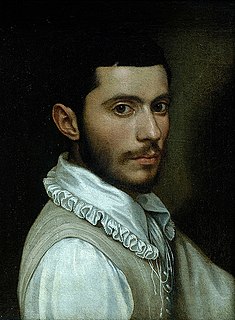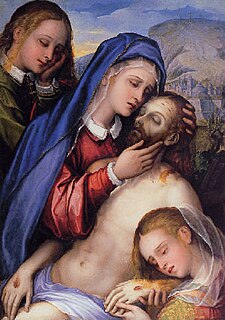Related Research Articles
Ottaviano Nonni, called Il Mascherino, was an Italian architect, sculptor, and painter born in Bologna. Apprentice of Giacomo Barozzi da Vignola, he was active in Emilia and in Rome, where he had been living in the rione of Borgo, in the road still bearing his name.

Scipione Pulzone, also known as Il Gaetano, was a Neapolitan painter of the late Italian Renaissance. His work differs in several respects from the Mannerist style predominant at the time. He was active mainly in Rome, but also worked in Naples and Florence. It is thought that he studied under Jacopino del Conte in Rome.

San Pietro Martire is a Roman Catholic church in Naples, Italy. It is located directly across from the principal building of the University of Naples on the main street, Corso Umberto corner with Via Porta di Massa, near the port area. In the piazza in front of the church is a statue of Ruggero Bonghi.

Santa Caterina a Formiello is a church in Naples, in southern Italy, located at the extreme eastern end of the old historic center of the city, on Via Carbonara and Piazza Enrico de Nicola, near the gate called Porta Capuana. The term Formiello comes from the forms or containers for water spouts found in the convent. Diagonally across the street and South is the Fontana del Formiello against the rear wall of the imposing Castel Capuano.

Marcello Venusti was an Italian Mannerist painter active in Rome in the mid-16th century.

Giacinto Brandi was an Italian painter from the Baroque era, active mainly in Rome and Naples.

Luigi Garzi was an Italian painter of the Baroque period, whose work displayed heavy influences of the Bolognese painter, Guido Reni.

Giovanni Bernardo Lama (1508–1579) was an Italian painter of the Renaissance period, active mainly in Naples. He was the son of a generally unknown artist, Matteo Lama. He was the apprentice of Giovanni Antonio D’Amato, then Polidoro da Caravaggio who had fled Rome after the Sack of 1527. He worked in the style of his friend and contemporary Andrea di Salerno. A Madonna and child with saints is in the sacristy of San Luca Evangelista in Praiano. A Deposition from the Cross is found in the Royal Basilica of San Giacomo Spagnoli in Naples.
Bernardo Tesauro (1440–1500) was an Italian painter of the Renaissance period. He was born in Naples. He was a relative of Filippo Tesauro. He was a pupil of Silvestre dei Buoni. He painted an Assumption of the Virgin for the church of San Giovanni Maggiore in Naples.
Raimondo Epifanio (1440–1482) was an Italian painter of the Renaissance period. Born in Naples. He studied under Silvestro Buono. One of his pupils was Andrea Sabbatini.
The decade of the 1480s in art involved some significant events.
The decade of the 1460s in art involved some significant events.
Terenzio Terenzi (1575–1621) was an Italian painter of the late-Renaissance or Mannerist period. Born near Pesaro, he is also known as Terenzio da Urbino or il Rondolino. He was a pupil of the painter Federigo Barocci. There is an altarpiece by Terenzi in the Cathedral of Sant'Andrea, a Baptism of Constantine in the quadreria di San Costanzo, and an Assumption of the Virgin (1621) in the church of the Cappuccini in Rome. According to Baglione, Terenzi visited Rome, where he was favored with the protection of Cardinal Montalto, nephew of Pope Sixtus V. Having practiced a deceptions on his benefactor by imposing on him a picture he himself painted for a work of Raphael, he was disgraced. There is a picture of his own composition in the church of San Silvestro, in Rome, representing the Virgin and Infant Christ, with several Saints.
Pompeo Landulfo was an Italian painter active mainly in Naples. He was born in Maddaloni near Caserta, Italy.
Buono de' Buoni was an Italian painter of the Quattrocento, active in his native Naples, Italy.
Silvestro is both a surname and a masculine Italian given name. Notable people with the name include:

Santa Maria ad Ogni Bene dei Sette Dolori, also known as Santa Maria de Sette Dolori, is a Roman Catholic church in Naples, Italy. It stands on a hill, providing an excellent view of Spaccanapoli, a Decumanus of Naples which ends across via Francesco Girardi. From the door of the church, one has a direct view across Naples through the straight decumanus. The church also faces the former convent of Santissima Trinità delle Monache.
Silvestro Morvillo, also called il Bruno or Silvestro Bruno was an Italian painter of the late-Renaissance period in Naples. Morvillo studied under Giovanni Bernardo Lama. One of his pupils was Antonio Sensibile born 1537.
Giuseppe de Lazzara was a Roman Catholic prelate who served as Bishop of Alife (1676–1702).
Antonio Savo de' Panicoli (1629–1687) was a Roman Catholic prelate who served as Bishop of Termoli (1677–1687).
References
- Farquhar, Maria (1855). Ralph Nicholson Wornum (ed.). Biographical catalogue of the principal Italian painters. London: Woodfall & Kinder. p. 33.